|
Note on the Blog Posts - I'm working to link some additional websites into the different posts if you'd like to find more information about a location or event. They show up in gray and underlined. What a long, full day. I asked everyone if someone else wanted to blog tonight and they all deferred (surprise, surprise). Hopefully in a day or two they'll get over their shyness and share some of their thoughts. :-) And today was a long, full day. Since it's my first time in El Salvador, today focused on history and context - helping us understand the past so we can better understand the people, their stories, and what's made El Salvador what it is today. And goodness there's a lot of history (and saying history feels weird because that makes you think of long ago but the history we focused on today happened either shortly before I was born or during my life time - I'm 33 for those of you who don't know) and it's not very pretty. In fact, it's violent, graphic, sad, horrible, and challenging. But it's truth and that's the important piece to remember - the truth is being shared and part of our responsibility as partners is to listen, learn, and work to understand. So, what was the truth we learned today 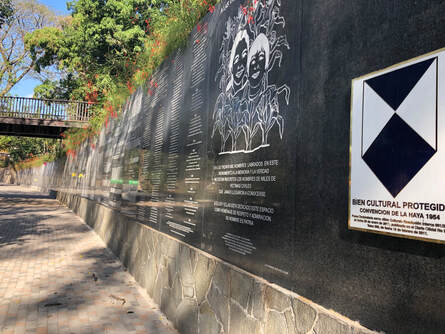 A view down the Monument to Memory and Truth. A view down the Monument to Memory and Truth. We started at Parque Cuscatlan (translation: Cuscatlan Park - my apologies to my Spanish speaking friends for the lack of accent - a project to figure out for my next blog post). It's a beautiful urban park and today was a gorgeous sunny day to be outside. In the park is a wonderful mural that tells an overview of El Salvador - from the thriving times of the indigenous peoples to the terror of the Spanish colonization of the land to the rising up of the people and the horrors of the civil war. It's all there on the wall. What comes at the end of the mural, though, is what makes it so striking - it's the Monument to Memory and Truth (the civilian casualty memorial wall). On first glance, it reminded me of the Vietnam Memorial as it's large and covered in names. The names on this wall are all of the people who were either murdered or disappeared beginning a few years before what's considered the official start of the civil war (1980) and its end. So every year has 2 sections homicidios (homicides) and desaparecidas/desaparecidos (essentially the people who disappeared - went out one day and then were never seen again) and under each section for each year is the list of names. And the list keeps growing. The monument was originally erected in 2003 with nearly 30,000 names and then a few years later an additional section that included over 3,000 more names was added, as well as a listing of all of the massacre sites in El Salvador (more on those tomorrow as we're headed out to one of the sites then). Also, this list of people is incomplete! Estimates put the dead at over 75,000 with thousands more disappearing throughout the civil war. I'm learning that down here, with regards to numbers related to the civil war, the best assumption to make is to assume the true number is underrepresented. The numbers were and are probably far greater than what we know. It was definitely a bit of a weird feeling - standing in a beautiful park, on a gorgeous day, reading a few names from the thousands upon thousands who were murdered or disappeared. 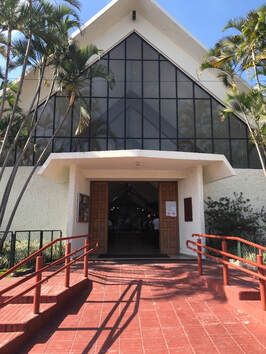 The Divina Providencia Chapel where Saint Oscar Romero was assassinated. The Divina Providencia Chapel where Saint Oscar Romero was assassinated. From Parque Cuscatlan, it was on to the Divina Providencia Hospital and Chapel (the Divine Providence Hospital and Chapel). The chapel is the site of the assassination of, the now saint, Oscar Romero. Romero was the fourth Archbishop of San Salvador, appointed in February of 1977. His appointment was welcomed by the government and wealthy of El Salvador because previously he had not really spoken out against them, the military, or anything that was happening throughout the country. However, in March of 1977, a good friend of his was assassinated and his death greatly impacted Romero. While he was already considered a friend of the people and the poor (he turned down living in the palace of the Archbishop to continue staying with the nuns at the Divina Providencia Hospital), after his friend's death, Romero became much more vocal about the atrocities that were happening. He had a weekly radio address he used to speak to the people in addition to his homilies. And he continually was working to ease the pain and suffering of the people. 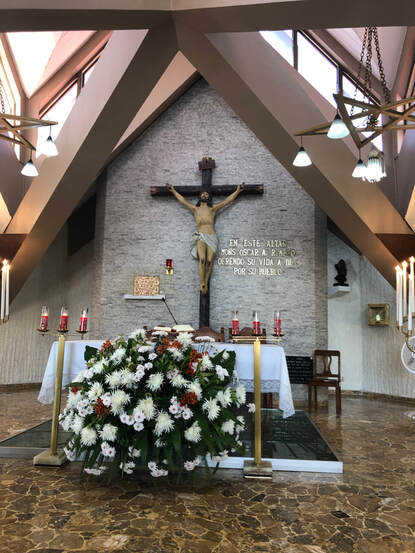 The altar at which Saint Oscar Romero was saying mass when he was assassinated. The altar at which Saint Oscar Romero was saying mass when he was assassinated. On 23 March 1980, Romero delivered a homily in which he appealed to the soldiers (ones committing the atrocities and massacres) to disobey the orders. He said, “In the name of God, in the name of this suffering people whose cries rise to Heaven more loudly each day, I implore you, I beg you, I order you in the name of God: Stop the repression!” (https://www.newyorker.com/news/daily-comment/archbishop-oscar-romero-becomes-a-saint-but-his-death-still-haunts-el-salvador) Most consider this to have been the moment that his death warrant was signed for the very next day, during a mass he was saying for a friend's family, he was assassinated. He was standing at the altar preparing for the offering when a car drove up the parkway right outside the chapel, turned around, and a single sniper rifle emerged and shot him. It's now said that Romero's life was the offering that day. There are photos documenting the moments immediately following, taken by the friend (a journalist) for whose family he was saying mass and then smuggled out by a nun so they would not be destroyed. 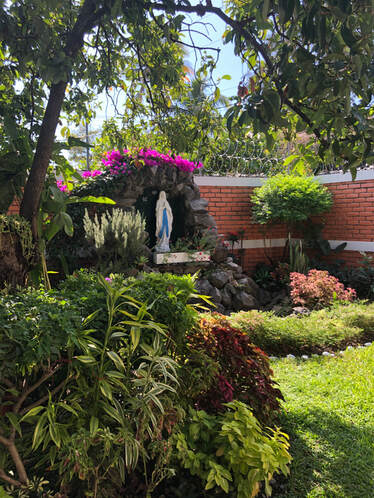 The garden outside Romero's home containing the grotto in which his heart rests. The garden outside Romero's home containing the grotto in which his heart rests. We saw those photos, as well as the small home which the nuns built Romero. It's been preserved basically as he left it and also has the clothes he was wearing that day, as well as the recording from the mass in which you can hear Romero speaking and then the gunshot. Outside is a beautiful garden which is home to the grotto that contains Romero's heart. Those assassinated were shot in the area related to their "sin." Romero's "sin" (his care for the poor) was considered a sin of the heart and so the sniper aimed for his heart. The bullet missed the heart and hit the aorta and the story is that during the autopsy, the nuns who were present for it requested they be given his heart as there was significant concern it would be destroyed or his body desecrated by the assassins. Their request was granted and for many years it was hidden in that garden area outside his home until finally, work was done to create the area you see in the picture. 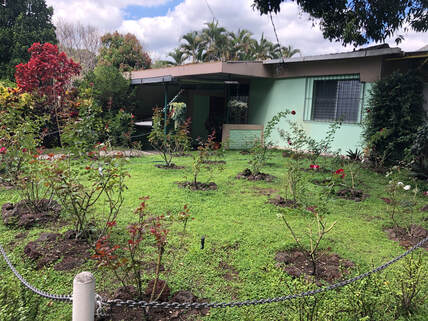 The rose garden at UCA - site of the massacre. The rose garden at UCA - site of the massacre. After Divina Providencia, we had one more site to visit before lunch and that was at UCA (University of Central America). In November 1989, soldiers stormed the university and massacred 6 Jesuit priests, their housekeeper, and her daughter (also known as the Jesuit massacre). The story was told that the military had found evidence that these priests were helping the people fighting for liberation and because of that ordered the assassination of one of the priests which included orders to leave no witnesses. 5 of the priests were killed in the garden, one in the dormitory, and the housekeeper and her daughter were killed in the room they were staying in. We were able to see the small museum that has been created there, which has on display all of the clothes the priests were wearing when they were killed, maps of locations, and other artifacts from their rooms and surrounding areas. We also saw the site of the massacre (the garden), the room where the housekeeper and daughter were killed, and then the chapel. Again, it was this strange dichotomy of beauty and violence. The groundskeeper at the time of the massacre was the husband of the housekeeper and so lost both his wife and daughter that night. He is the one who turned the massacre site into a rose garden, planted 6 red rosebushes for the Jesuit priests and 2 yellow rosebushes for his wife and daughter. Later, additional rosebushes were added to symbolize the other assassinations (such as Oscar Romero) and massacres (such as El Mozote, which is where we're headed tomorrow) that happened throughout the civil war. 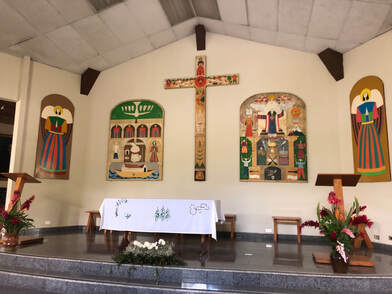 Art in the Chapel at UCA. Art in the Chapel at UCA. The chapel was also very beautiful with some significant artwork that was imbued with meaning. But placed in it are some very graphic depictions of the Stations of the Cross, created by an artist who would go out to observe the violence and torture that was happening, and then draw those scenes for the record. They were definitely difficult to see, but again, it's the telling of the story, the truth of what was really happening. If you'd like to see them, you can find them at the following link, but please know, they are very graphic depictions of torture and prepare yourself for that: UCA Stations of the Cross. One of the challenges of learning all of these things, is also learning that my country (our country), the United States, supported the government and military of El Salvador through much of the civil war. We sent over 1 million dollars a day in support. The soldiers who committed many of these crimes, including the massacres, were trained in the United States. This is a piece of our history (and our current foreign policy) that we don't learn about in school--that we have funded/supported and are funding/supporting people who are committing these crimes. We have and are funding and supporting violence, massacres, torture, and who knows what else. And that's a piece of the truth we need to hear and be aware of. It's a piece of the truth that I'm still processing and trying to figure out. None of this is easy. It's hard, challenging, and overwhelming. What I know, though, is that Jesus said, "I am the Truth." And so the truth must be told. It must be shared. We must learn from it - no matter how difficult it might be. And then, after all of that, it was finally time for lunch. :-) We ate at a place by the Artisan Shops, had some time to do a little shopping, and then hit the road for Berlin (pronounced Ber-leen - again my apologies for no accent). It's a beautiful drive going down the mountains, across the valley and river, then back up the mountains to the town. Although, I definitely slept through some of it, as my brain was processing everything we'd seen before lunch. :-) 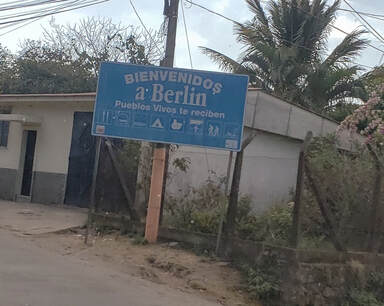 Translation - "Welcome to Berlin. A vibrant community ready to receive you." Translation - "Welcome to Berlin. A vibrant community ready to receive you." So, we have arrived safely at the Pastoral House in Berlin! The women are wonderful and were so excited to see Tim and Gary and Bev (the one with the purple hair) again. We had some time to settle in during which we also worked on the gifts that we'll be taking to the families of our community in the coming days, then supper, time of reflections, some final prep for our families, and then bed. So, as I said at the beginning, a long and full day. There's another on deck tomorrow as we're headed out to the site of the El Mozote massacre. But that's for tomorrow. This is enough for today.
Jessica
0 Comments
Leave a Reply. |
AuthorFeb. 2020 Delegation ArchivesCategories |
Proudly powered by Weebly
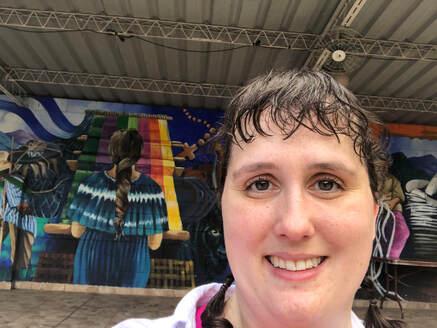
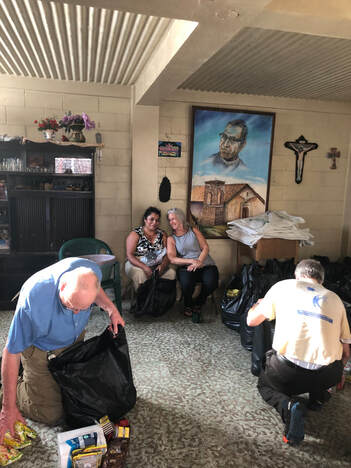
 RSS Feed
RSS Feed